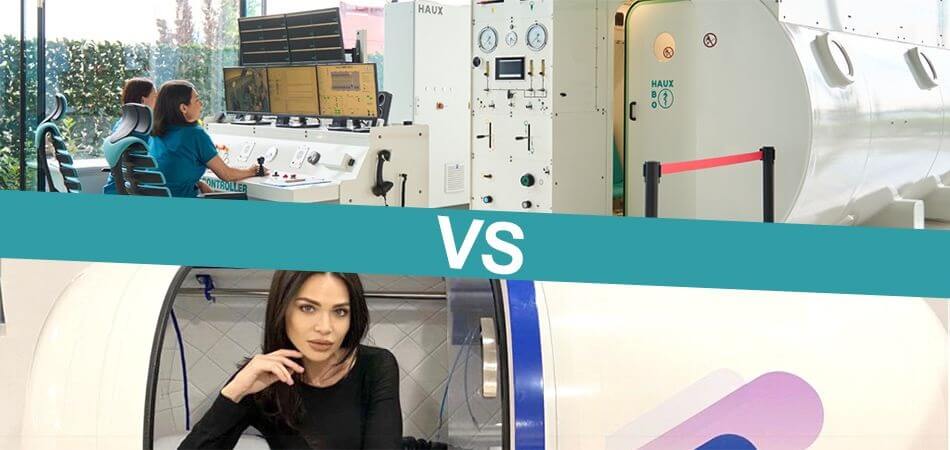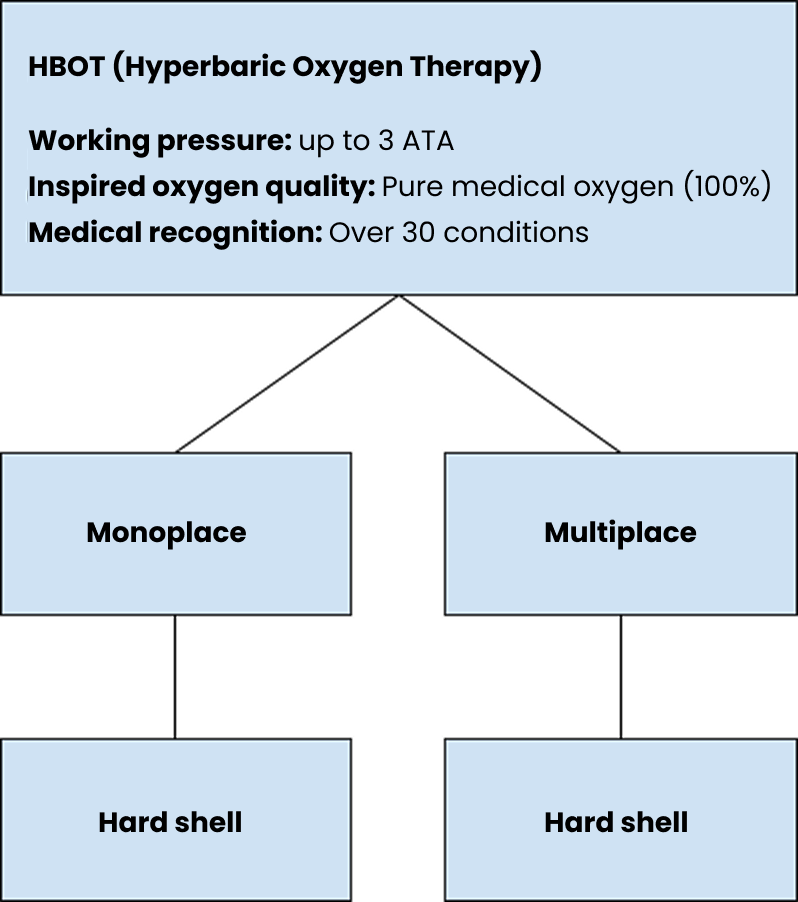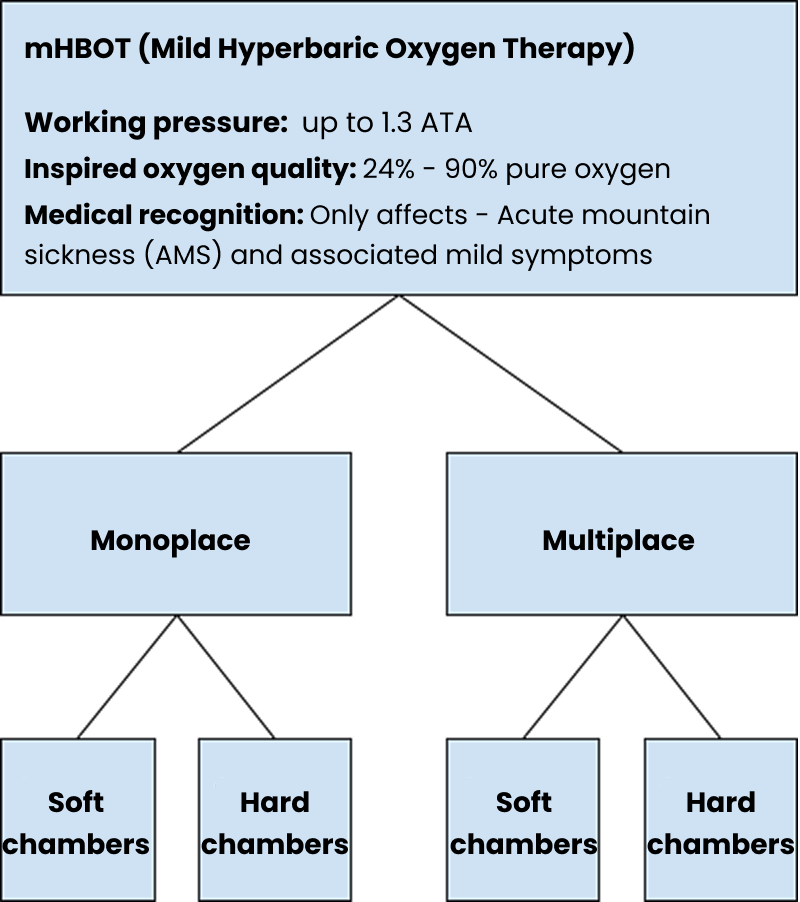
Article reviewed by: Dr. Sturz Ciprian, Dr. Tîlvescu Cătălin and Dr. Alina Vasile
HBOT or mHBOT chamber?
Hyperbaric chambers are split into 2 categories, HBOT and mHBOT. Although they seem similar, the technical differences and medical benefits between the two can be vast.
The main technical differences are given by the working pressure and the purity of the oxygen used in the therapy.


HBOT (Hyperbaric Oxygen Therapy) chambers
These are medical devices, certified under Class IIB, in accordance with CEE 93/42. They work with pure medical oxygen (100%) and the working pressure can reach up to 3 ATA. Their shell will always be a hard one and they can accommodate between 1 and 30 people.
In Romania, HBOT chambers require accreditation from the ANMDM and authorization from the Ministry of Health. The HBOT chamber can only operate in the presence of qualified medical personnel and periodically certified operators.
- It can only be used in authorized hospitals or medical clinics
- Requires medical clearance to operate
- Working pressure up to 3 ATA
- 100% pure medical oxygen is used in the therapy
- HBOT multi-place chambers allow medical intervention, including in Intensive Care mode
- HBOT multi-place chambers have high-performance fire extinguishing systems (HSFS)
- Over 300 published medical studies (LINK)
- Protection against voltage fluctuations or drops
- Approved at the European level for 30 different conditions
mHBOT (mild Hyperbaric Oxygen Therapy) chambers
mHBOT ("mild hyperbaric oxygen therapy") chambers are non-medical hyperbaric devices that can have either a hard or a soft shell. They have between 2-6 places and work with oxygen of lower purity than medical oxygen. The oxygen used in mHBOT chambers is generated by oxygen concentrators, whose purity can vary between 24% - 90%. The average pressure at which mHBOT chambers operate is 1.3 ATA.
With production costs up to 30 times lower than HBOT medical hyperbaric chambers, they are increasingly found in beauty salons or spas. mHBOT chambers do not require any medical authorization or the presence of qualified medical personnel. They are not classified as medical devices and cannot be used to administer medical treatments.
The European Committee of Hyperbaric Medicine (ECHM) and the European Baromedical Society (EUBS) define very clearly the differences between HBOT and mHBOT chambers. Read the ECHM and UHMS official position on mHBOT chambers. LINK
Fire risk and medical intervention in HBOT chambers
Inside the HBOT chamber, due to the amount and extremely high inflammability of oxygen, access with electronic or heat-emitting devices is not permitted. Safety rules are strictly followed to prevent any injury to the patient as well as to the medical staff.
According to European and international standards, multi-place HBOT chambers must have a pneumatically activated fire-fighting system, but also an access hatch for patients or for emergency access by medical personnel.
Treatment efficacy and recommended treatment plan
The duration of treatment is also important. Although the costs for therapy sessions in the mHBOT chambers may seem lower, the average duration is 60-90 minutes, and in the HBOT chamber, the treatment lasts about 120 - 150 minutes.
Hyperbaric oxygenation treatment has a cumulative effect, so for maximum effectiveness, the number and duration of sessions, chamber pressure, and oxygen purity are all important to the success of the treatment.
In all treatment tables recommended by ECHM and EUBS, the working pressure must be between 2 - 3 ATA and the oxygen purity must be above 99.5%
When visiting an accredited HBOT medical center, depending on the condition, the doctor of hyperbaric medicine will decide on the recommended treatment table and the number of sessions required.
Why does the confusion between the two persist?
Although at the European level, it is forbidden to promote mHBOT chambers in the administration of medical treatments, unfortunately, we often find the description of HBOT treatment procedures and principles among the promotional materials of mHBOT chambers.
This misleads the patient and sometimes doctors as to the real characteristics of the respective hyperbaric chamber, causing very long delays in the application of an appropriate medical treatment, at key moments in the evolution of the disease.
Contributing to this confusion is the fact that certain medical clinics have decided to purchase such (non-medical) mHBOT devices for cost reasons, which are considerably cheaper than HBOT chambers.
Comparison of main features:
| HBOT Chamber | mHBOT Chamber |
|---|---|
| Maximum working pressure | |
| 3 ATA (tested up to 6 ATA) | 1.3 ATA |
| Quality of inspired oxygen | |
| Pure medical oxygen (100%) | Oxygen of purity 24% - 90% |
| Staff required | |
| At least one clinical specialist doctor with skills in hyperbaric medicine + At least 2 hyperbaric chamber operators, certified + Medical Assistant | mHBOT chambers do not require the presence of a certified operator or a medical professional |
| Wrapper type | |
| C-Steel hard shell, PED certified + Acryl PMMA, PVHO-1 and NFPA 99 certified | Can be hard or soft shell. There is no standard for material |
| Permission to operate | |
| HBOT chambers require medical authorization to operate | mHBOT chambers do not require medical authorization to operate |
| Classification | |
| Class IIB Medical Device | Not classified as a medical device |
| Fire extinguishing system | |
| The HBOT multi-location chambers have a high-performance fire-fog and water-extinguishing system (HSFS) | mHBOT chambers do not have fire extinguishing systems |
| Duration of therapy | |
| Most often between 120 - 150 minutes depending on the schedule | 60 - 90 minutes |
| Location/Location | |
| HBOT chambers can only be used in authorized hospitals or medical clinics | mHBOT cameras are often used in cosmetic salons and clinics, aesthetic and beauty clinics or at home |
| Medical studies | |
| More than 300 published medical studies attesting to the effectiveness of treatment in HBOT chambers (LINK) | The number of studies attesting to the effectiveness of medical treatment in mHBOT devices is very limited |
| Protection against voltage drops | |
| There must be a protection system against fluctuations or drops in electrical voltage | In mHBOT chambers there is no mandatory protection against voltage fluctuations or drops |
| Medical Recognition | |
| FDA approved for 14 different conditions, European Committee of Hyperbaric Medicine (ECHM) approved for over 30 different conditions, Society of Hyperbaric and Underwater Medicine (UHMS) approved for 14 different conditions, Society approved European Baromedical Association (EUBS) | Recommended by the FDA and the Underwater and Hyperbaric Medicine Society (UHMS) for a single condition: acute mountain sickness (AMS) and associated mild symptoms. It is not approved or recommended by the European Committee of Hyperbaric Medicine (ECHM). It is not approved or recommended by the European Baromedical Society (EUBS) |




